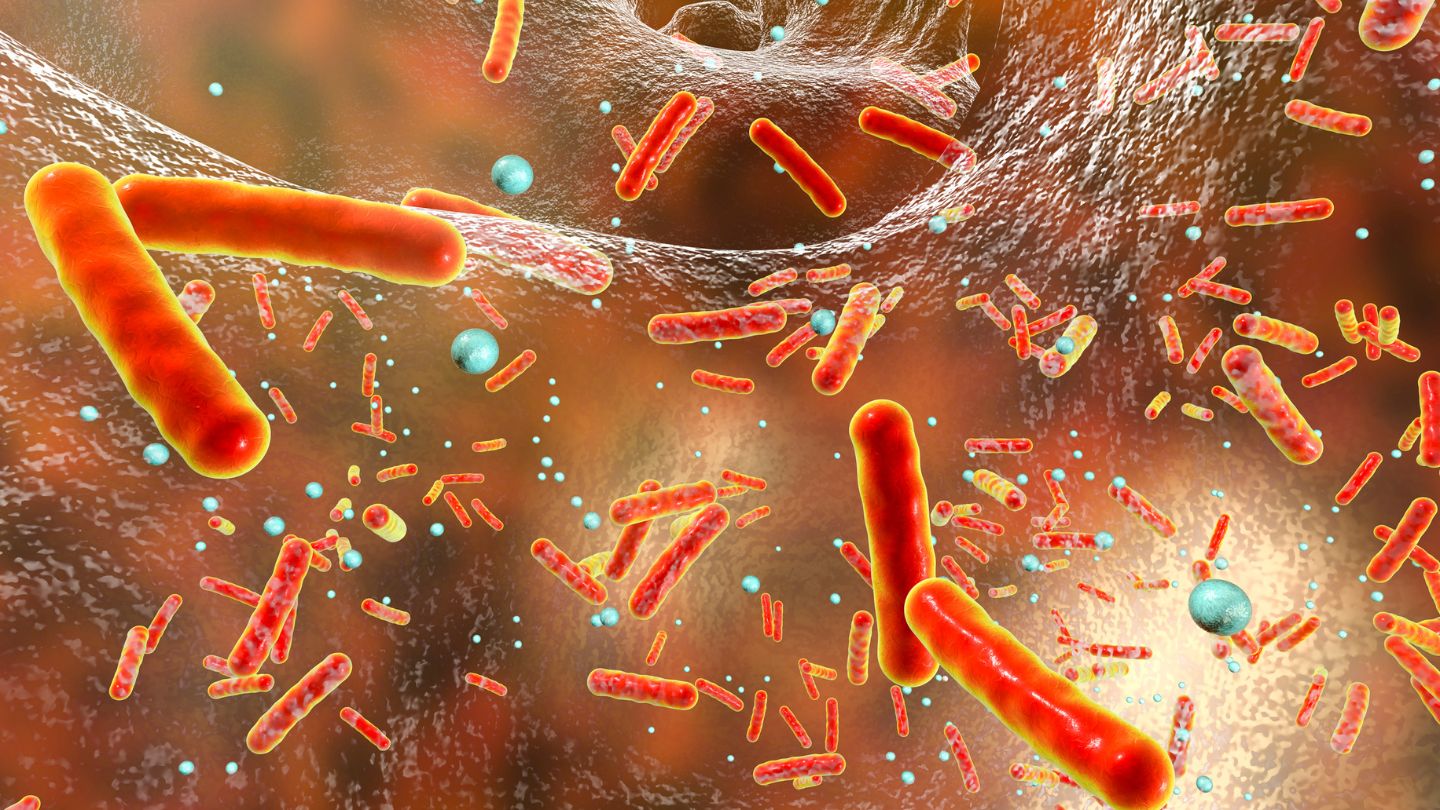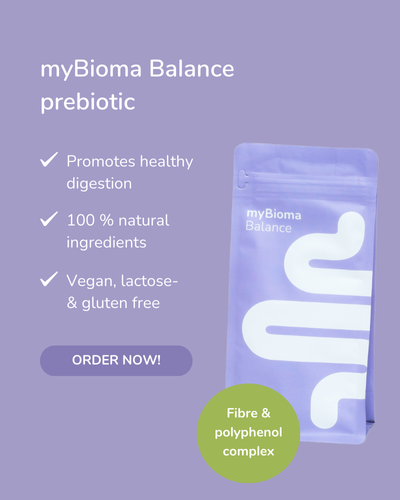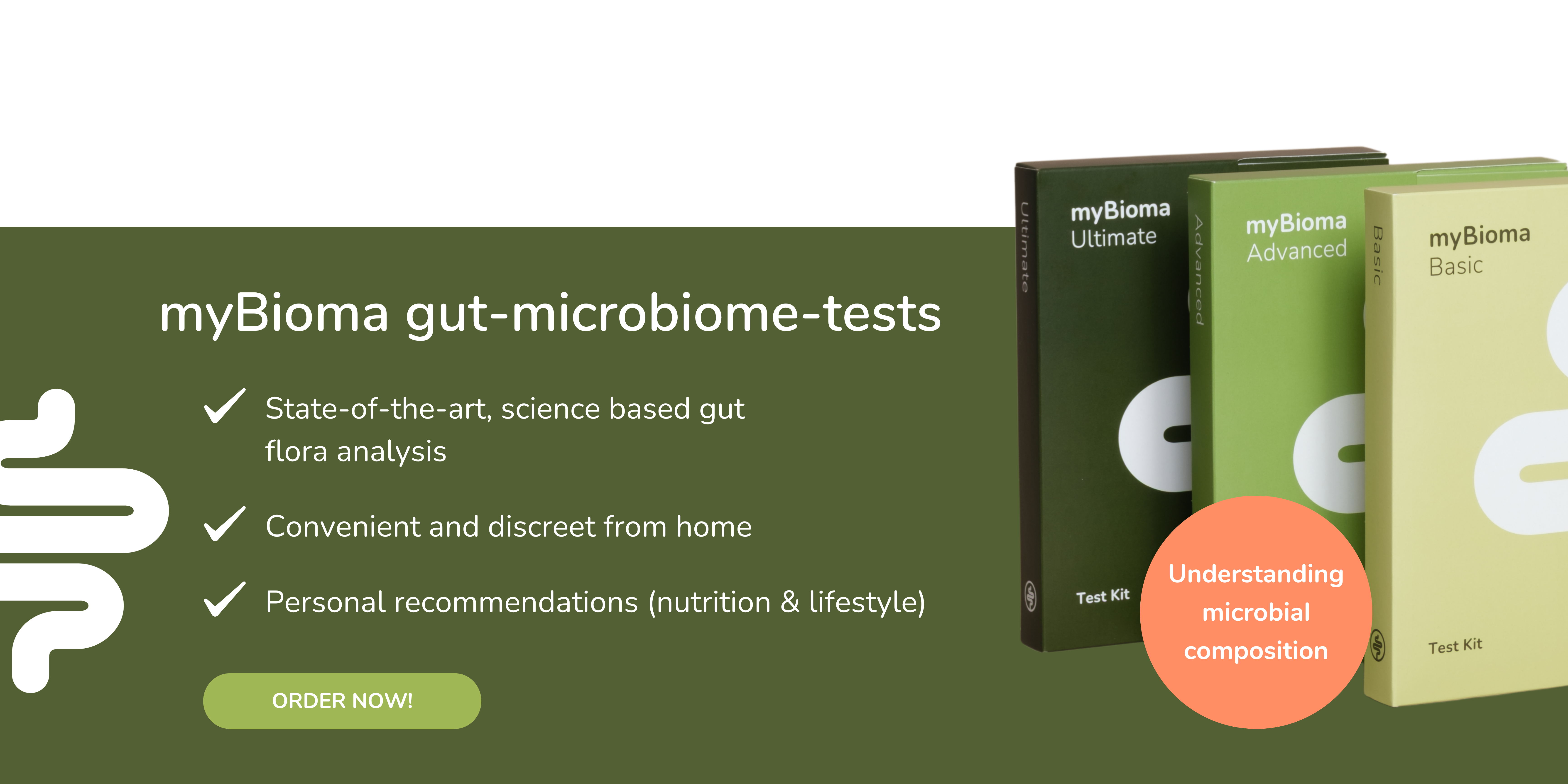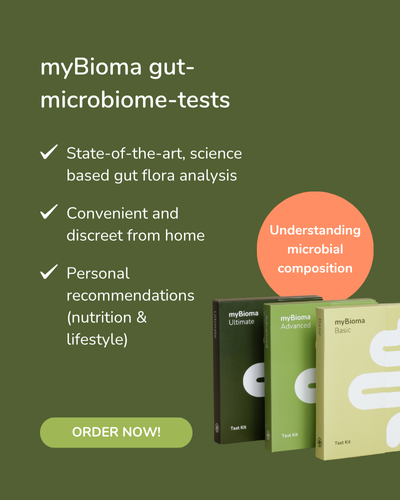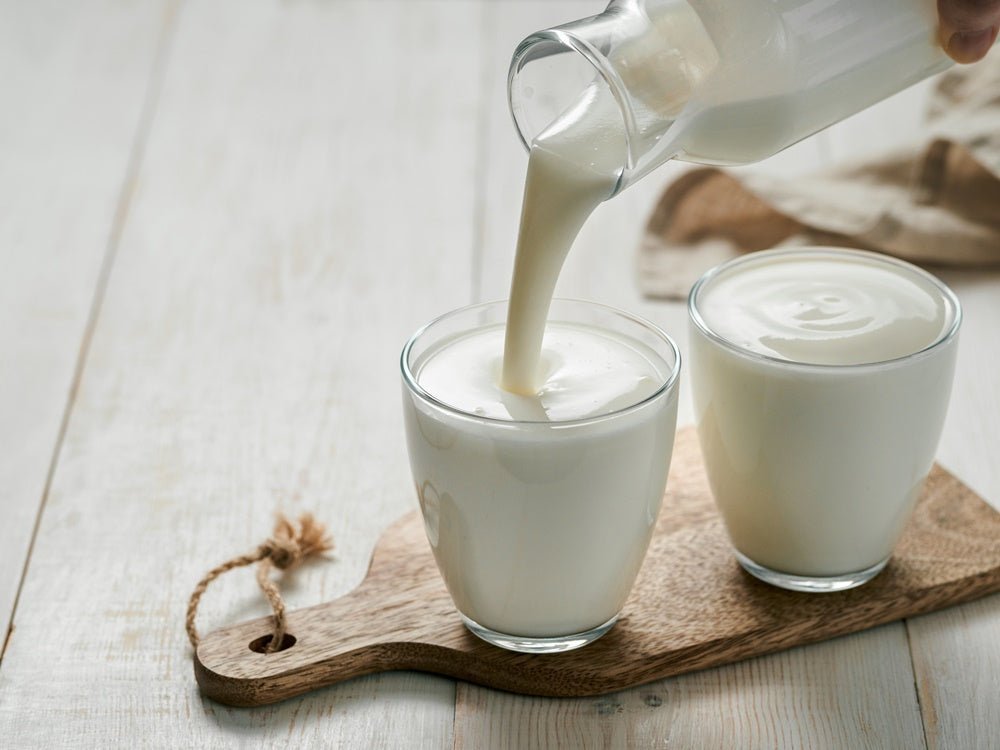Table of contents
- What are bifidobacteria?
- Which bifidobacteria are there that promote our health?
- Which positive effects do bifidobacteria have on our health?
- What role do bifidobacteria play in women’s health?
- Bifidobacteria in different stages of life
- Which foods contain bifidobacteria?
- Which foods support the growth of bifidobacteria?
- Practical tips: Supporting bifidobacteria in your body
- Intake of bifidobacteria through dietary supplements
- What happens if there are too few bifidobacteria in my gut microbiome?
- Summary
Bifidobacteria are an important part of our gut microbiome and support our health in many ways. They accompany us from birth and are responsible for many important tasks. In this article, you will discover how bifidobacteria positively impact our bodies and the consequences of an imbalanced gut microbiome.
What are bifidobacteria?
The genus Bifidobacteria belongs to the phylum Actinobacteria and includes a variety of gram-positive, immobile, non-spore-forming, rod-shaped bacteria. They are strictly anaerobic, meaning they can only grow and survive in environments without oxygen. The large intestine provides an ideal habitat for them, but they can also be found in the oral cavity, vagina, and breast milk (1,2).
Bifidobacteria accompany us throughout our lives: They are one of the first bacteria to colonize the body of newborns and become an integral part of the gut microbiome over the course of life. They play a central role in the health development of children and lay the foundation for a healthy gut microbiome, which has a long-term positive effect on health in adulthood (1,3). If you would like to learn more about the development of the gut microbiome in childhood, read our blog article on how to promote gut health in children.
Which bifidobacteria are there that promote our health?
As of 2020, there are around 82 species of bifidobacteria, but only a small number of them occur in humans (4). The best-known types of bifidobacteria and their potentially positive effects on the human organism are the following (5):
| B. infantis | May relieve irritable bowel symptoms and support the treatment of necrotizing enterocolitis in premature infants. |
|
B. animalis subsp. lactis |
May relieve constipation, reduce the frequency of urinary tract infections in children, aid in the treatment of necrotizing enterocolitis in premature infants, reduce dental plaque, lower total cholesterol levels and the risk of upper respiratory tract disease. |
|
B. bifidum |
May lower total cholesterol levels in blood plasma, aid in the treatment of necrotizing enterocolitis in premature infants, and help with acute diarrhea in children. |
|
B. longum |
May prevent or support the treatment of necrotizing enterocolitis in premature babies, relieve irritable bowel symptoms and have a positive effect on gastrointestinal diseases. |
|
B. brief |
May aid in the prevention and treatment of necrotizing enterocolitis in premature infants and lower total cholesterol levels in adults. |
Which positive effects do bifidobacteria have on our health?

Bifidobacteria are probiotic bacteria that, when present in sufficient quantities in the gut microbiome, have been shown to positively impact human health. The table below outlines some of these potential effects. However, it's important to note that further studies, particularly those involving humans, are necessary to clearly confirm these findings.
| Defense against pathogens | Bifidobacteria can combat a wide range of harmful microorganisms. For instance, the B. longum strain has the ability to eliminate pathogens such as E. coli, salmonella, and listeria. This occurs through the production of bacteriocins - special substances that kill pathogenic microorganisms, helping to reduce the frequency of infections (6). |
| Defense against viruses | Bifidobacteria are not only effective against harmful bacteria but also against viruses. Strains like B. adolescentis and B. longum have demonstrated antiviral properties (6). |
| Possible anti-cancer effect | In animal studies, bifidobacteria have shown potential in preventing colon and liver cancers. Laboratory studies also suggest that this effect could extend to human cancer cells (6). |
| Anti-inflammatory effect | Bifidobacteria exhibit therapeutic effects in inflammatory bowel diseases such as irritable bowel syndrome (IBS) and necrotizing enterocolitis in premature infants. Additionally, they exert an anti-inflammatory effect in the oral cavity, helping to prevent infections there (6,7). |
| Alleviating lactose intolerance | Certain bifidobacteria can help ease the symptoms of lactose intolerance - such as diarrhea, bloating, and abdominal pain - by promoting the breakdown of lactose in the gut, which improves digestion of dairy products (6). |
| Supporting a healthy vaginal flora | Bifidobacteria, along with lactobacilli, are key health-promoting bacteria in the vagina. They produce lactic acid and hydrogen peroxide, which help maintain a low pH level in the vagina, thereby inhibiting the growth of harmful bacteria (8). |
| Mental health support | Bifidobacteria are considered psychobiotics, meaning they can impact stress resistance and mental health. Studies have shown that taking certain bifidobacteria can alleviate depressive symptoms and improve overall mental well-being (6,9). |
| Protection of the cardiovascular system | Various studies suggest that taking bifidobacteria as a dietary supplement can reduce the risk of heart disease, diabetes, high blood pressure, and obesity. This is primarily due to their influence on fat metabolism (1,6). |
| Promoting nutrient absorption | Bifidobacteria can enhance the absorption of vitamins and calcium, ensuring that the body has more nutrients available (6). |
| Influence on bone health | Animal studies suggest that B. longum may have a positive effect on bone density and osteoporosis, while B. adolescentis may support the healing of bone fractures (6). |
| Regulation of the immune system | Bifidobacteria play a crucial role in both the development and regulation of the immune system. They contribute to the development of the immune system in children and can also influence the adult immune system by promoting antibody production and stimulating specific immune cells (6). |
What role do bifidobacteria play in women’s health?
Lactobacilli are the predominant bacteria in the vaginal microbiome, where they help maintain a low pH and create a protective barrier against pathogens by producing lactic acid. Bifidobacteria also produce lactic acid, thereby supporting women’s health in a similar manner.
Typically, bifidobacteria account for 5-10% of the bacteria in the vaginal flora. However, the species of bifidobacteria present in the vagina differ from those found in the intestines. While the intestinal bifidobacteria are well-documented, more research is needed to identify and understand the specific species of bifidobacteria in the vaginal flora (8).
Bifidobacteria in different stages of life
Bifidobacteria are among the first microorganisms to colonize the human intestine and remain there throughout life. In newborns, they can constitute up to 90% of the gut microbiome, playing a crucial role in the healthy development of the immune system and overall health. In adulthood, the proportion of bifidobacteria in the gut decreases to 2-14%. This proportion declines even further after the age of 70 (6,10).
How do bifidobacteria enter the body?
During vaginal birth, a newborn is exposed to the mother's vaginal flora, which includes bifidobacteria. These bacteria are among the first to colonize the infant's intestines and establish the initial gut microbiome (11). Breastfeeding provides another source of bifidobacteria, as breast milk contains these beneficial bacteria, which then become part of the baby’s digestive system (3,11).
In adulthood, various factors and practices can influence the number of bifidobacteria in the body (10–13):

As we age, the amount of bifidobacteria in the gut decreases. A healthy lifestyle can help promote the growth of these beneficial bacteria in our gut.
Which foods contain bifidobacteria?
The fermentation process used to produce yogurt, kefir, and cheese allows these bacteria to multiply and naturally enrich these foods (14). Additionally, bifidobacteria can be found in other fermented plant-based products, such as sauerkraut and kimchi (5).
Which foods support the growth of bifidobacteria?
Prebiotic foods provide essential nutrients that support the growth and activity of bifidobacteria in our gut. To ensure these beneficial bacteria can multiply effectively and exert their positive effects, it is advisable to include the following prebiotic foods in your daily diet (15):
- Vegetables: garlic, salsify, artichokes, onions, asparagus, leeks, etc.
- Fruit: bananas, tomatoes, apples, plums, citrus fruits, etc.
- Berries: Blueberries in particular are particularly rich in prebiotics.
- Legumes : lentils, chickpeas and beans
- Honey and algae
You can find more information about prebiotics and probiotics in this blog post: Prebiotics and probiotics – Can they really influence our health?
Practical tips: Supporting bifidobacteria in your body
- Consume probiotic foods several times a week. These include yogurt, kefir, sauerkraut, kimchi, kombucha, etc.
- Make your own fermented foods. Try our recipes for yogurt, kefir and kimchi.
- Maintain a healthy lifestyle: alcohol consumption, smoking, lack of exercise and sleep have a negative effect on the beneficial bacteria in your gut.
- Only take antibiotics in emergencies: Only take antibiotics when absolutely necessary and always under the guidance of a healthcare professional. Antibiotics can kill both harmful pathogens and beneficial bacteria.
- Consume prebiotic foods or supplements. Include prebiotic foods or supplements in your diet to support the growth of bifidobacteria. For example, our prebiotic supplement, myBioma Balance, can be easily integrated into your morning routine, added to a smoothie, or used for our delicious nicecream recipe.
Intake of bifidobacteria through dietary supplements
Probiotic supplements offer a convenient way to introduce bifidobacteria into your diet. By definition, probiotics are products that contain live cultures in sufficient quantities to benefit your health (16). When choosing a probiotic supplement, select a high-quality product from a reputable manufacturer to ensure efficacy.
For optimal results, probiotics should be taken in conjunction with prebiotic foods or prebiotic supplements. Prebiotics serve as the primary food source for probiotic bacteria, allowing them to thrive and exert their beneficial effects. Providing these essential nutrients helps ensure that the probiotic strains can effectively colonize your gut and deliver their positive health benefits.
When should I take bifidobacteria?
Bifidobacteria can be beneficial in various situations. For example, they may help alleviate symptoms associated with lactose intolerance and irritable bowel syndrome (IBS) (6). Additionally, taking probiotics like bifidobacteria and lactobacilli can be useful after a gastrointestinal infection to help rebuild the gut microbiome.
To assess whether the ratio of bifidobacteria in your gut is balanced, consider taking a myBioma microbiome test.
What happens if there are too few bifidobacteria in my gut microbiome?
A lack of bifidobacteria can disrupt the balance of the gut microbiome. This can lead to the proliferation of harmful bacteria and pathogenic microorganisms. This imbalance can affect various physiological processes and lead to various complaints. These include (13):
- Leaky gut barrier: A weakened intestinal mucosa allows pathogenic bacteria to enter the body from the intestine and cause disease.
- Irritable bowel syndrome: diarrhoea, constipation, cramps and digestive problems
- Deterioration of psychological and mental health: Our gut microbiome communicates with the brain via the gut-brain axis. The lack of probiotic bacterial strains is associated with diseases such as autism or depression.
- Weakened immune system: Many of the important gut bacteria support immune cells in their work. If this support is lost, viruses and pathogens can spread more easily and cause illness.
Summary
Bifidobacteria are essential "heroes" in our gut microbiome. A healthy lifestyle, including a balanced diet rich in fiber, can foster their growth in the gut. Additionally, incorporating probiotics and prebiotics can provide valuable extra support to maintain a healthy balance of these beneficial bacteria.
References
- Tang J, Wei Y, Pi C, Zheng W, Zuo Y, Shi P, et al. The therapeutic value of bifidobacteria in cardiovascular disease. npj Biofilms Microbiomes. 2023 Oct 30;9(1):82.
- Supragingival Microbes. In: Atlas of Oral Microbiology [Internet]. Elsevier; 2015 [cited 2024 Aug 17]. p. 41-65. Available from: https://linkinghub.elsevier.com/retrieve/pii/B9780128022344000033
- Akagawa S, Akagawa Y, Yamanouchi S, Kimata T, Tsuji S, Kaneko K. Development of the gut microbiota and dysbiosis in children. Bioscience of Microbiota, Food and Health. 2021;40(1):12–8.
- Duranti S, Longhi G, Ventura M, Van Sinderen D, Turroni F. Exploring the Ecology of Bifidobacteria and Their Genetic Adaptation to the Mammalian Gut. Microorganisms. 2020 Dec 22;9(1):8.
- Fijan S. Microorganisms with Claimed Probiotic Properties: An Overview of Recent Literature. IJERPH. 2014 May 5;11(5):4745–67.
- Chen J, Chen X, Ho CL. Recent Development of Probiotic Bifidobacteria for Treating Human Diseases. Front Bioeng Biotechnol. 2021 Dec 22;9:770248.
- Srivastava S, Basak U, Naghibi M, Vijayakumar V, Parihar R, Patel J, et al. A randomized double-blind, placebo-controlled trial to evaluate the safety and efficacy of live Bifidobacterium longum CECT 7347 (ES1) and heat-treated Bifidobacterium longum CECT 7347 (HT-ES1) in participants with diarrhea-predominant irritable bowel syndrome. Good Microbes. 2024 Dec 31;16(1):2338322.
- Freitas AC, Hill JE. Quantification, isolation and characterization of Bifidobacterium from the vaginal microbiomes of reproductive aged women. Anaerobic. 2017 Oct;47:145–56.
- Wang H, Braun C, Murphy EF, Enck P. Bifidobacterium longum 1714TM Strain Modulates Brain Activity of Healthy Volunteers During Social Stress. Am J Gastroenterol. 2019 Jul;114(7):1152–62.
- Odamaki T, Kato K, Sugahara H, Hashikura N, Takahashi S, Xiao J zhong, et al. Age-related changes in gut microbiota composition from newborn to centenarian: a cross-sectional study. BMC Microbiol. 2016 Dec;16(1):90.
- Kim H, Sitarik AR, Woodcroft K, Johnson CC, Zoratti E. Birth Mode, Breastfeeding, Pet Exposure, and Antibiotic Use: Associations With the Gut Microbiome and Sensitization in Children. Curr Allergy Asthma Rep. 2019 Apr;19(4):22.
- Martinez JE, Kahana DD, Ghuman S, Wilson HP, Wilson J, Kim SCJ, et al. Unhealthy Lifestyle and Gut Dysbiosis: A Better Understanding of the Effects of Poor Diet and Nicotine on the Intestinal Microbiome. Front Endocrinol. 2021 Jun 8;12:667066.
- Hills R, Pontefract B, Mishcon H, Black C, Sutton S, Theberge C. Gut Microbiome: Profound Implications for Diet and Disease. Nutrients. 2019 Jul 16;11(7):1613.
- Sibanda T, Marole TA, Thomashoff UL, Thantsha MS, Buys EM. Bifidobacterium species viability in dairy-based probiotic foods: challenges and innovative approaches for accurate viability determination and monitoring of probiotic functionality. Front Microbiol. 2024 Feb 2;15:1327010.
- Maftei NM, Raileanu CR, Balta AA, Ambrose L, Boev M, Marin DB, et al. The Potential Impact of Probiotics on Human Health: An Update on Their Health-Promoting Properties. Microorganisms. 2024 Jan 23;12(2):234.
- Bischoff SC, editor. Probiotics, prebiotics and synbiotics [Internet]. Stuttgart: Georg Thieme Verlag; 2009 [cited 2024 May 18]. Available from: http://www.thieme-connect.de/products/ebooks/book/10.1055 /b-002-29652
- Hill C, Guarner F, Reid G, Gibson GR, Merenstein DJ, Pot B, et al. The International Scientific Association for Probiotics and Prebiotics consensus statement on the scope and appropriate use of the term probiotic. Nat Rev Gastroenterol Hepatol. 2014 Aug;11(8):506–14.


